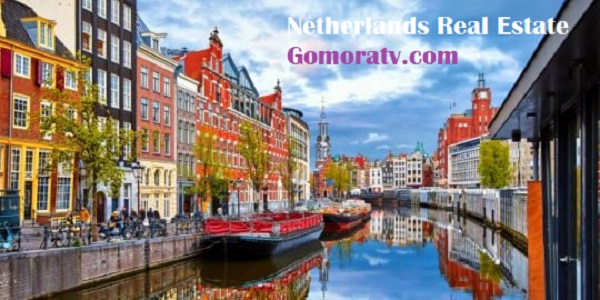A Guide to Real Estate in the Netherlands
A Guide to Real Estate in the Netherlands, The Netherlands, with its charming canals, windmills, and vibrant towns, is a popular place to buy real estate. This guide covers key subjects to assist you in navigating the Dutch real estate market as a buyer or investor:

Market Dynamics:
Steady Growth: The Dutch real estate market has been expanding steadily in recent years, and prices are predicted to rise gradually going forward.
High Demand, Limited Supply: High demand is seen in major cities like Rotterdam, Utrecht, and Amsterdam, which could result in competitive marketplaces and higher pricing.
Expat-Friendly: The Netherlands welcomes expats, with many English speakers in major cities.
Buying Process:
Real Estate Agent (Makelaar): It’s essential to use a local, NVM-certified Makelaar. They can help you with the talks, the process, and the paperwork.
Offer & Acceptance: There is potential for negotiating during the informal offer procedure. A purchase agreement is signed upon acceptance.
Notary: A notary completes the sale, takes care of the paperwork, and makes sure everything goes smoothly. Notary costs are paid by the buyer.
Inspections: While not mandatory, consider getting a property inspection to identify potential issues.
Financing:
Mortgages: The majority of buyers use mortgages. In general, down payments are higher than in some other countries (20–30%). For non-residents, there might be stricter mortgage requirements.
Also Read: London-Based Real Estate Companies
Costs to Consider: Include closing charges such as land register fees, notary fees, and transfer tax. These can be substantial, sometimes amounting to more than 5% of the property’s value.
Additional Considerations:
VvE (Owners’ Association): A VvE is in charge of shared expenses and maintenance for many apartment buildings. Examine the VvE’s condition and any associated costs before making a purchase.
Leasehold vs. Freehold: The majority of properties are freehold, but some may be leasehold (erfpacht), meaning the landowner must pay an annual ground rent.
Cost of Living: When assessing affordability, take upkeep, homeowner’s insurance, and property taxes into account.
Types of Properties in the Netherlands
The Netherlands offers a variety of housing options, catering to different lifestyles and budgets. Here’s a breakdown of some common property types you’ll encounter:
Single-Family Homes:
Detached Houses (Vrijstaande woningen): The most seclusion and room are provided by these standalone homes. Families or anyone looking for a sense of freedom would find them perfect. They are typically more expensive than alternative solutions, though.
Semi-Detached Houses (Twee onder een kap): These homes provide good seclusion and outdoor space with a front and back yard while sharing a wall with another residence. They offer a decent middle ground between a terraced home and a detached home.
Urban Dwellings:
Terraced Houses (Rijkshuizen): These types of dwellings are the most common in the Netherlands. Single-family homes with shared walls on both sides are arranged in these rows. They offer a great balance of affordability, community, and space. The front and back of many terraced residences have little gardens.
Apartments (Appartementen): Apartments are a common option in urban regions with high population densities. They range in size from large family apartments to flats. Common communal spaces in apartment buildings include rooftop terraces, bike racks, and laundry rooms.
Unique Dutch Options:
Houseboats ( woonboten): In the Netherlands, houseboat living is a unique experience. Houseboats are anchored in Leiden, Utrecht, and Amsterdam on canals. It offer a charming and practical lifestyle, but they can also have capacity issues and require extra considerations like upkeep and mooring licenses.
Additional Considerations:
Location: The availability and sorts of properties can change based on the location. While single-family homes may be more common in suburbs and rural areas, city centers will likely have a higher proportion of apartments.
Budget: Terraced and semi-detached homes are the next most expensive kind of real estate, behind detached homes. A flat’s price may change depending on its amenities, location, and size.
Lifestyle: Think about your preferences and needs. Do space and privacy rank highly for you? Do you think a central location and a local feel are important? Selecting the appropriate kind of property is essential to having a great time while residing in the Netherlands.
Note:
Regulations: Renovating or altering a building may be subject to restrictions, particularly for historic structures or houseboats. Before contemplating a property of this kind, seek advice from local authorities or a real estate expert.
It will be easier for you to narrow down your search and select the perfect home that meets your needs in terms of location, lifestyle, and budget if you are aware of the many types of homes available in the Netherlands.